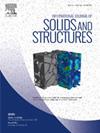Integrated design of novel composite plate-truss hybrid lattice structures for superior energy absorption
IF 3.4
3区 工程技术
Q1 MECHANICS
International Journal of Solids and Structures
Pub Date : 2025-05-09
DOI:10.1016/j.ijsolstr.2025.113447
引用次数: 0
Abstract
Conventional truss lattice structures are prone to stress concentration and shear banding under crushing loads, while plate lattice structures suffer from limited mechanical improvement due to narrow crushing spaces and manufacturing defects. A novel composite plate-truss hybrid lattice structure inspired by deep-sea glass sponges addresses these limitations by combining the lightweight performance of truss structures with the robust mechanical properties of plate-lattice structures. It can achieve a high energy absorption capacity by adjusting its geometric parameters. The powerful 3D printing technology of Multi Jet Fusion verified the feasibility of the novel composite square plate-truss hybrid structural design. The theoretical prediction model of the mean crush force of square plate-truss hybrid structure composite was established. Quasi-static compression tests and impact tests confirmed the accuracy of finite element results, while the deformation failure modes and mechanical responses of the new structure were analyzed. Compared to typical lattice structures, the novel composite square plate-truss hybrid structure demonstrates a larger effective crushing region, more stable mechanical response, and superior energy absorption characteristics. The impact of different geometric parameters on the mechanical properties of the proposed structure is discussed through parametric analysis, highlighting the significant influence of wall thickness on bearing and energy absorption characteristics. Furthermore, medium and low-speed impact loads were studied to assess the structural deformation characteristics, mechanical properties, and energy absorption. The results prove the reliability of the design method and show the deformation and energy absorption characteristics of different hybrid structures under different impact velocities. The bionic hybrid design strategy proposed in this study provides a promising way to significantly improve the mechanical properties of lattice structures and impact protection engineering
新型复合板-桁架混合晶格结构的集成设计,具有优异的吸能性能
传统的桁架晶格结构在破碎荷载作用下容易出现应力集中和剪切条带,而板晶格结构由于破碎空间狭窄和制造缺陷,其力学性能提升有限。受深海玻璃海绵的启发,一种新型复合板-桁架混合晶格结构通过将桁架结构的轻质性能与板-晶格结构的坚固力学性能相结合,解决了这些限制。通过调整其几何参数,可以获得较高的能量吸收能力。强大的Multi Jet Fusion 3D打印技术验证了新型复合方板-桁架混合结构设计的可行性。建立了方板桁架混合结构复合材料平均压溃力的理论预测模型。准静态压缩试验和冲击试验验证了有限元结果的准确性,并对新结构的变形破坏模式和力学响应进行了分析。与典型的点阵结构相比,新型复合材料方板桁架混合结构具有更大的有效破碎区域、更稳定的力学响应和更好的能量吸收特性。通过参数分析,讨论了不同几何参数对所提出结构力学性能的影响,突出了壁厚对承载和能量吸收特性的显著影响。此外,还研究了中低速冲击载荷对结构变形特性、力学性能和能量吸收的影响。结果证明了该设计方法的可靠性,并展示了不同混合结构在不同冲击速度下的变形和能量吸收特性。本研究提出的仿生混合设计策略为显著提高晶格结构的力学性能和冲击防护工程提供了一条有希望的途径
本文章由计算机程序翻译,如有差异,请以英文原文为准。
求助全文
约1分钟内获得全文
求助全文
来源期刊
CiteScore
6.70
自引率
8.30%
发文量
405
审稿时长
70 days
期刊介绍:
The International Journal of Solids and Structures has as its objective the publication and dissemination of original research in Mechanics of Solids and Structures as a field of Applied Science and Engineering. It fosters thus the exchange of ideas among workers in different parts of the world and also among workers who emphasize different aspects of the foundations and applications of the field.
Standing as it does at the cross-roads of Materials Science, Life Sciences, Mathematics, Physics and Engineering Design, the Mechanics of Solids and Structures is experiencing considerable growth as a result of recent technological advances. The Journal, by providing an international medium of communication, is encouraging this growth and is encompassing all aspects of the field from the more classical problems of structural analysis to mechanics of solids continually interacting with other media and including fracture, flow, wave propagation, heat transfer, thermal effects in solids, optimum design methods, model analysis, structural topology and numerical techniques. Interest extends to both inorganic and organic solids and structures.

 求助内容:
求助内容: 应助结果提醒方式:
应助结果提醒方式:


